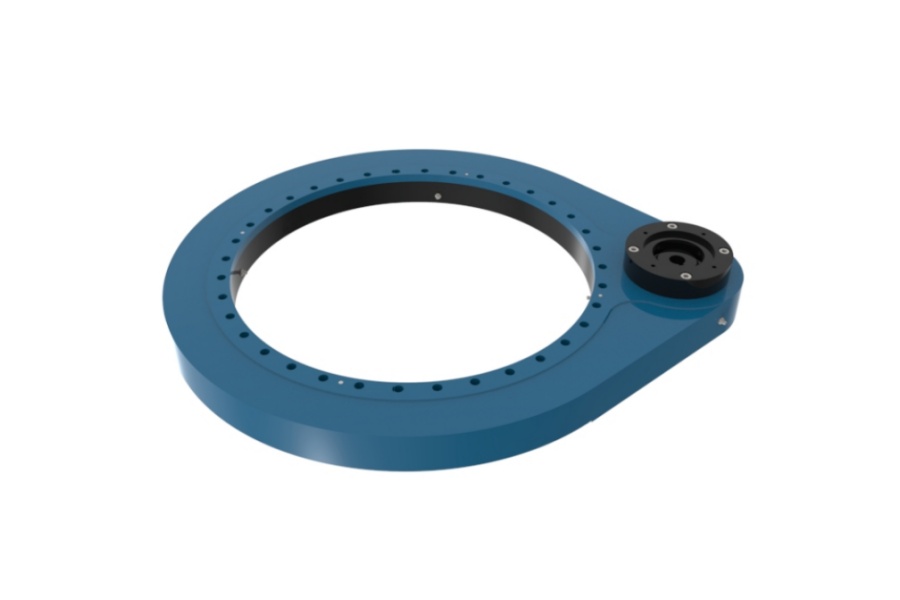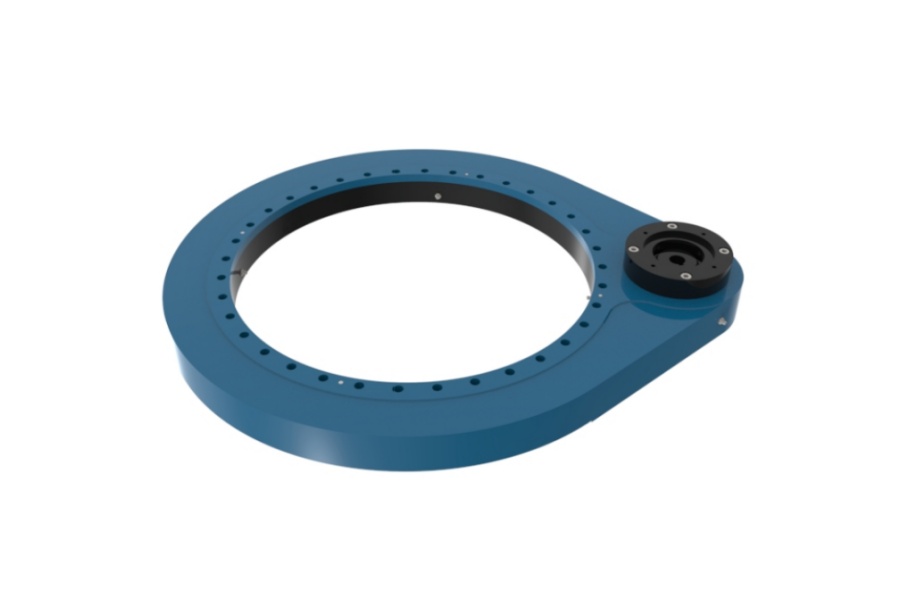
Распространенные проблемы поворотного привода и их решения
Что такое поворотный привод?
АПоворотный приводЭлектромеханический привод, объединяющий поворотный подшипник, червячный редуктор, корпус и уплотнительные элементы в единый предварительно собранный узел. Его основная техническая функция заключается в обеспечении контролируемого непрерывного вращательного движения вокруг одной оси с одновременной поддержкой сложных комбинаций осевых нагрузок (параллельных оси вращения), радиальных нагрузок (перпендикулярных оси) и моментных нагрузок (опрокидывающих сил). Основной принцип действия основан на червячном механизме, где прецизионно обработанный червячный винт входит в зацепление с зубчатым венцом, встроенным либо во внутреннюю, либо во внешнюю обойму поворотного подшипника. Входное вращение от подключенного электро- или гидродвигателя вращает червяк, который, в свою очередь, приводит в движение шестерню, обеспечивая медленное и мощное вращение всего подшипникового узла. Такая конфигурация обеспечивает высокое одноступенчатое передаточное отношение, позволяя преобразовывать высокоскоростное вращение двигателя с низким крутящим моментом в низкоскоростное выходное вращение с высоким крутящим моментом, что необходимо для перемещения массивных грузов. Важнейшей особенностью многих стандартных конструкций червячных передач является их способность к самоторможению, которая предотвращает обратный ход под действием выходных сил и позволяет системе надежно удерживать тяжелые грузы в неподвижном положении без внешнего тормоза. Поворотные приводы изначально разработаны для упрощения механической конструкции, сокращения времени сборки и обеспечения компактного, прочного и высоконадежного решения для обеспечения интенсивного вращательного движения в самых разных промышленных и мобильных приложениях.

Распространенные проблемы поворотного привода и их решения
Поворотные приводы разработаны для обеспечения долговечности, но могут испытывать определенные эксплуатационные отказы; понимание этих проблем, их первопричин и применение правильных решений имеют решающее значение для предотвращения дорогостоящих простоев. Необычный рабочий шум, такой как скрежет, щелчки или ритмичный стук, часто указывает на серьезные основные проблемы. Этот акустический сигнал обычно возникает из-за недостаточной смазки, вызывающей контакт металла с металлом, загрязнения абразивными частицами внутри дорожки качения или физического повреждения зубьев шестерен, такого как питтинг, сколы или поломка зубьев. Диагностическое решение начинается с немедленного отключения работы для предотвращения дальнейшего повреждения. Необходим тщательный контроль качества и уровня смазки, а затем полная продувка и повторная смазка указанным производителем типом смазки. Если шум сохраняется, обязателен полный внутренний осмотр на предмет видимых повреждений шестерен и подшипников, часто требующий профессиональной разборки и замены компонентов. Отказ смазки представляет собой еще одну чрезвычайно распространенную категорию проблем. Недостаточная смазка ускоряет износ и повышает рабочую температуру, а избыточная смазка может создавать избыточное внутреннее давление, что приводит к разрушению критически важных уплотнений и попаданию смазки в области, где она может притягивать загрязнения. Оптимальным решением является строгое соблюдение предписанного производителем графика смазки, использование только сертифицированных типов смазок и всегдае соблюдение правильной процедуры снятия сливной пробки во время технического обслуживания для полного удаления старой смазки и предотвращения опасного повышения давления.
Попадание загрязнений является основной причиной преждевременного выхода из строя поворотного привода. Проникновение абразивных частиц, таких как пыль, песок или металлические частицы, действует как притирочная паста, ускоряя износ прецизионных поверхностей зубчатых передач и дорожек подшипников. Это происходит почти исключительно из-за выхода из строя или повреждения первичных уплотнений. Решение проблемы требует немедленной замены уплотнений компонентами, указанными производителем оборудования, полной разборки и очистки внутренней дорожки качения шестерни при подозрении на загрязнение, а также полной замены смазочного материала. В суровых условиях может потребоваться замена уплотнений на более прочные материалы или более частое техническое обслуживание. Перегрев является серьезным признаком, который может ухудшить свойства смазочного материала и вызвать отжиг термообработанных компонентов, что приводит к катастрофической потере твердости. К распространенным причинам относятся чрезмерные рабочие нагрузки, превышающие номинальную мощность привода, несоосность привода и входного двигателя, непрерывная работа на высоких скоростях или использование смазочного материала неправильной вязкости. Для решения этой проблемы необходимо убедиться, что рабочие нагрузки соответствуют проектным значениям, проверить и устранить проблемы со выравниванием, обеспечить надлежащую смазку и обеспечить достаточное время охлаждения приводов в условиях интенсивной циклической работы. Наконец, чрезмерный люфт или полная потеря движения указывают на серьёзное внутреннее повреждение. Люфт возникает из-за нормального износа или неправильной регулировки предварительного натяга, в то время как заклинивание часто возникает из-за серьёзного отказа компонента, например, поломки червячного вала или заклинивания подшипников. Решения требуют профессиональной оценки; люфт можно устранить регулировкой предварительного натяга, если это позволяет конструкция, в то время как заклинивание обычно требует полной переборки или замены узла квалифицированным специалистом.
Характеристики поворотных приводов
Поворотные приводы характеризуются уникальным набором механических характеристик, делающих их незаменимыми в тяжёлом машиностроении. Их важнейшим преимуществом является непревзойдённая способность справляться с разнонаправленными нагрузками. Единый компактный блок тщательно спроектирован для одновременной поддержки значительных осевых, радиальных и моментных нагрузок, что устраняет необходимость в сложных опорных конструкциях, изготавливаемых по индивидуальному заказу, и значительно упрощает проектирование системы для инженеров-изготовителей оригинального оборудования. В основе его функциональности лежит интегрированный червячный механизм, обеспечивающий исключительно высокое передаточное отношение на одной ступени. Это приводит к созданию огромного выходного крутящего момента при относительно небольшом входном усилии двигателя, обеспечивая огромное механическое преимущество в компактном корпусе. Фундаментальной и зачастую критически важной характеристикой является самоблокировка, обеспечиваемая конструкцией червячной передачи. Специальная геометрия и трение внутри зубчатой передачи предотвращают обратный ход выходных сил, эффективно создавая внутреннюю тормозную систему, которая надёжно удерживает положение без дополнительных внешних тормозов, что крайне важно для обеспечения безопасности в таких областях применения, как подъём и позиционирование.
Кроме того, поворотные приводы обеспечивают превосходную точность и управляемость. Редуктор обеспечивает исключительно плавное и точное позиционирование при вращении, что крайне важно для высокоточных приложений, таких как слежение за солнцем, промышленная робототехника и нацеливание спутниковых антенн. Их интегрированная и модульная конструкция обеспечивает значительное инженерное преимущество. Объединяя подшипник, редуктор, уплотнения и монтажные интерфейсы двигателя в один предварительно собранный, испытанный и герметичный узел, поворотные приводы значительно снижают сложность проектирования, минимизируют время сборки, снижают затраты на складские запасы и повышают общую надежность системы для производителей оборудования. Такой высокий уровень интеграции также способствует исключительной структурной жесткости и крутильной жесткости внутри базовой машины, минимизируя прогиб под большой нагрузкой и обеспечивая точное, повторяемое движение. Наконец, современные поворотные приводы сконструированы для максимальной прочности и долговечности в жестких условиях эксплуатации. Они оснащены высококачественными закаленными или поверхностно закаленными материалами зубчатых передач, усовершенствованными многоступенчатыми системами уплотнений для защиты от загрязнений и влаги и рассчитаны либо на смазку на весь срок службы, либо на легкодоступные точки обслуживания, что гарантирует надежную работу в самых разных условиях: от морских установок на шельфе до засушливых, пыльных строительных площадок.
Применение поворотных приводов
Уникальное сочетание высокого крутящего момента, компактной конструкции и высокой несущей способности привело к повсеместному внедрению поворотных приводов в широком спектре отраслей. Доминирующее и быстро расширяющееся применение находится в секторе возобновляемой энергетики. В солнечной энергетике поворотные приводы являются основным исполнительным механизмом в одноосных и двухосных системах слежения за солнцем. Они обеспечивают точное, медленное вращение, необходимое для ориентации массивов фотоэлектрических панелей, тщательно следуя траектории солнца, чтобы максимизировать эффективность сбора энергии на 25-30% по сравнению со стационарными системами. Их способность к самоблокировке здесь необходима для предотвращения непреднамеренного перемещения, вызванного сильными ветровыми нагрузками. Аналогичным образом, в ветроэнергетике поворотные приводы являются критически важными компонентами в системах управления как рысканием, так и тангажом турбин. Система рыскания использует несколько мощных приводов для поворота всей гондолы в направлении преобладающего ветра, в то время как система тангажа использует надежные приводы внутри ступицы для индивидуальной регулировки угла каждой лопасти с целью оптимизации выработки электроэнергии и осуществления аэродинамического торможения в штормовых условиях.
Строительство, горнодобывающая промышленность и тяжелое машиностроение представляют собой еще один крупный сектор, принципиально зависящий от технологии поворотных приводов. Они являются ключевым компонентом, обеспечивающим полный поворот верхних частей экскаваторов на 360 градусов, точное поворотное движение стрел мобильных кранов и точное позиционирование стрел бетононасосов и подъемных рабочих платформ. Их компактная конструкция и исключительно высокая удельная мощность делают их идеально подходящими для условий ограниченного пространства и чувствительных к весу условий эксплуатации мобильной техники. Помимо этих областей, поворотные приводы играют важную роль в робототехнике и промышленной автоматизации, где они обеспечивают мощное и точное вращение осей для сварочных роботов, паллетизаторов, мощных позиционеров и автоматизированных сборочных линий. В аэрокосмической и оборонной отраслях они используются в системах радиолокации, спутниковой связи и наблюдения для точного позиционирования антенн, где они должны обеспечивать непревзойденную надежность и точность в экстремальных условиях окружающей среды и при строгих требованиях безопасности. Дополнительные области применения находят в палубных кранах и лебедках на кораблях и морских судах, в медицинском диагностическом оборудовании, таком как сканеры КТ и МРТ для позиционирования пациентов, а также в индустрии развлечений для вращения тяжелых сцен, концертных акустических систем и крупных осветительных установок.
Факторы, влияющие на цену поворотного привода
Стоимость поворотного привода сильно варьируется и определяется сложным взаимодействием технических характеристик, требований к производительности, выбора материалов и коммерческих факторов. Наиболее важным фактором, определяющим стоимость, являются физические размеры и номинальная грузоподъёмность устройства. Более крупные приводы с большим диаметром подшипников, увеличенными модулями зубчатых передач и более высокой грузоподъёмностью требуют значительно больше сырья и требуют более сложной механической обработки, сложных процессов термообработки и более высоких производственных затрат. Следовательно, привод, рассчитанный на нагрузку 150 тонн, будет экспоненциально дороже компактного привода, предназначенного для лёгких применений. Требуемые характеристики точности и производительности также оказывают прямое и существенное влияние на конечную цену. Поворотный привод, изготовленный для сверхточной работы с практически нулевым люфтом в аэрокосмической или медицинской промышленности, требует исключительно жёстких производственных допусков, использования высококачественных компонентов (таких как керамические подшипники или шестерни, шлифованные по индивидуальному заказу), а также расширенного контроля качества, сертификации и испытаний, что в совокупности приводит к значительно более высокой стоимости по сравнению с приводом, предназначенным для общепромышленного применения, где небольшой люфт допустим.
Выбор материалов и спецификаций защиты от коррозии – ещё один важный фактор, влияющий на конечную цену. Стандартный привод из углеродистой стали с базовой промышленной окраской представляет собой наиболее экономичный вариант. Однако использование усовершенствованной защиты от коррозии, такой как горячее цинкование, фирменные покрытия, такие как Geomet®, или изготовление всего узла из нержавеющей стали (например, марки 316 для морской среды), существенно увеличивает базовую стоимость. Уровень адаптации и интегрированных функций, пожалуй, является наиболее изменчивым фактором стоимости. Стандартный, каталогизированный узел, доступный в готовом виде, будет наиболее доступным. Любые доработки, включая специальные монтажные фланцы или схемы расположения болтов, встроенные абсолютные энкодеры высокого разрешения для позиционной обратной связи, специальные крепления для конкретных гидравлических или электродвигателей или специальные решения по герметизации для экстремальных температур или химического воздействия, требуют дополнительного проектирования, уникальных производственных процессов, специализированных компонентов и специальных испытаний, что значительно увеличивает цену. Объём заказа и каналы поставок также играют решающую роль благодаря экономии за счёт масштаба. Крупносерийный заказ, размещаемый непосредственно у производителя для OEM-проекта, позволяет амортизировать единовременные затраты на проектирование (NRE) и оснастку на множество единиц продукции, что значительно снижает цену каждой единицы. В то же время, закупка единичной единицы продукции через дистрибьютора для проведения технического обслуживания и ремонта будет иметь значительно более высокую себестоимость. Наконец, динамика внешнего рынка, включая глобальные колебания цен на сырье (особенно на сталь и специальные сплавы), валютные курсы, тарифы и логистику глобальной цепочки поставок, может влиять на базовую цену компонентов и конечную стоимость готовой продукции.
Поставщик поворотных приводов
ЛИРАДРАЙВКомпания LYRADRIVE является ведущим производителем и мировым поставщиком высокопроизводительных поворотных приводов и специализированных решений. Компания заслужила прочную репутацию благодаря инженерному совершенству, точности производства и бескомпромиссной приверженности качеству продукции, долговечности и поддержке клиентов. LYRADRIVE предлагает обширный портфель как стандартных, так и полностью индивидуальных поворотных приводов, тщательно спроектированных и испытанных для удовлетворения жестких требований различных отраслей, включая возобновляемую энергетику, строительство, обработку материалов, промышленную автоматизацию и оборону. Ключевым преимуществом LYRADRIVE является клиентоориентированный и совместный инженерный подход, основанный на сотрудничестве с клиентами от этапа первоначального проектирования до производства, монтажа и обслуживания на протяжении всего жизненного цикла для разработки приводных решений, которые легко интегрируются в конкретные приложения, оптимизируя производительность, грузоподъемность, устойчивость к внешним воздействиям и пространственные ограничения. Специализированные глобальные команды технической поддержки и послепродажного обслуживания предоставляют экспертные консультации, обеспечивая оптимальную производительность системы, минимальное время простоя и долгосрочную эксплуатационную надежность. Кроме того, LYRADRIVE уделяет особое внимание строгому контролю и обеспечению качества на протяжении всего производственного процесса, используя материалы высочайшего качества, самые современные технологии производства и комплексные протоколы испытаний, чтобы гарантировать исключительную производительность, безопасность и ценность каждого устройства в самых сложных условиях эксплуатации в мире.



